
|
Sale 75
September Pre Long Beach
| Lot |
Photo |
Description |
Realized |
Lot 1072 |
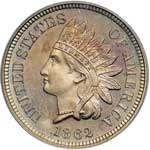 |
1862. PCGS graded Proof 64. Good mirrors with frosted devices. A very attractive example with great eye appeal. There is a slight stain, possibly from a removed spot by the A in STATES which likely limited the grade. Housed in an Old Green Holder. Only 550 struck. Pop 134; 112 finer. (PCGS # 2259) Estimated Value $700 - 850
View details and enlarged photos
Check results on similar lots
| Realized
$805 |
Lot 1073 |
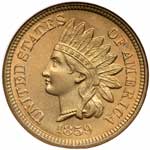 |
1859. NGC graded MS-65. CAC Approved. Attractive pastel mint luster on the obverse, while the reverse is flamingly stunning. Housed in an Old Style Holder. Pop 156; 14 finer, 3 in 65+, 10 in 66, 1 in 67.
1859: A one-year Type. In a letter to the Secretary of the Treasury, Mint Director Snowden wrote on December 13, 1859, "A modification of the devices on the reverse of the cent is desirable. I propose to introduce the shield upon the reverse. This will give it a more National character, and be a decided improvement upon the present coin. I enclose a few specimen pieces I have caused to be struck." [Here, he is referring to the Judd-228 Pattern pieces.]. Estimated Value $3,500 - 4,000
View details and enlarged photos
| Realized
$4,025 |
Lot 1074 |
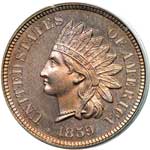 |
1859. PCGS graded Proof 65. A popular one-year type with great eye appeal. Good mirrors with just a few light fly specks. Only 800 struck. Pop 55; 23 finer, 1 in 65, 21 in 66, 1 in 67. (PCGS # 2247)
Popular and important as a one year type design featuring Longacre's Indian head design and a simple reverse incorporating a Laurel wreath around the denomination, "ONE CENT". However, the obverse portrait is actually "Lady Liberty", a Caucasian representation of Liberty borrowed from the Three Dollar design of 1854. She wears a headdress of a Native American of the Chippewa tribe. The reverse is more properly an olive wreath, although the laurel wreath description is somewhat accurate as their leaves are visually similar. Estimated Value $3,000 - 3,500
View details and enlarged photos
Check results on similar lots
| Realized
$4,600 |
Lot 1075 |
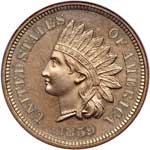 |
1859. NGC graded Proof 64. CAC Approved. Medium mirrors. Very few marks. The coins that were struck between 1859 and 1864 were composed of 88 percent copper and 12 percent nickel, as required by law. In 1864, the weight of the coins was reduced from 72 grains to the present weight of 48 grains, and the alloy changed to 95 percent copper and 5 percent tin and zinc. Research in 1863 indicated that bronze was an excellent alloy for minor coins, and so the copper-nickel alloy was discontinued. Total production of the Indian Head cent was 1,849,648,000 pieces.Housed in an Old Style Holder. Pop 88; 61 finer.
History behind the nickel metal in the U.S. Flying Eagle and Indian Cents. Yes, politics played a major role. Joseph Wharton (in the 1850s a holder of a monopoly on nickel mines in the Western Hemisphere) began writing pamphlets advocating his metal for coinage: It then had no commercial use and was unpopular among metallurgists because it was excessively difficult to work. As Wharton was closely connected with the Philadelphia Mint's ruling families, and moreover had immense political influence, Mint and Treasury authorities paid close attention to all his proposals for the next 30 years.
By late 1853, when the Mint was losing money on every Large cent it made, and copper blanks threatened to become unobtainable at any price, James C. Booth (then Melter and Refiner, and one of the foremost chemists of his day) proposed two simplified versions of Feuchtwanger's metal, which would also earn money for Wharton. The lighter-colored of these consisted of 40% nickel, 40% copper, 20% zinc; the darker 30% nickel, 60% copper, 10% zinc. Booth still later attempted a third alloy 40% nickel, 60% copper. None of these was practical: The two ternary alloys, when bright and new, were easily confused with silver; when dulled, they respectively resembled tin and lead--raising the fear of counterfeits in those metals. Booth's 40-60 cupro-nickel alloy proved impossibly difficult to melt, roll, cut into blanks, and strike; the planchets were hard enough to damage steel dies! Nevertheless, partly because the Mint establishment and Congress were thickly seeded with Wharton's friends, experiments with nickel continued. Protests quickly followed that the metal was justifying its old name Kupfer-Nickel, 'devil's copper,' requiring the very fires of hell even to melt!
Finally, in early 1856, Mint Director Snowden (one of Wharton's longtime friends and neighbors from the Delaware Water Gap area of Pennsylvania) decided on an alloy of 88% copper, 12% nickel, at a weight of 72 grains (4.666 grams = 80 to the troy pound), for the new cents. In July 1856 he sent the Treasury a batch of 50 half cents struck on blanks of this new alloy, and his congressional friends accordingly pushed through a bill to authorize the new Flying Eagle coinage. This became law Feb. 21, 1857. Estimated Value $1,350 - 1,500
View details and enlarged photos
| Realized
$2,185 |
Lot 1076 |
 |
1860. PCGS graded Proof 64. CAC Approved. A scarcer date. Year of the famous Pony Express. Slightly muted mirrors, which is typical with this issue. Slight mark on the cheek. Housed in an Old Green Holder. Only 1,000 struck. Pop 56; 51 finer, 41 in 65, 10 in 66. (PCGS # 2253)
Operated in 1860 as a private venture, without subsidy, by W. H. Russell, Alex Majors and W. B. Waddell, the Pony Express carried tissue paper mail at speeds previously unknown between St. Joseph, Missouri and Sacramento, California in a hoped-for profitable venture to prove the feasibility of a central route to Pacific; the goal was also to secure United States government mail contracts. The Pony Express played vital part in holding California to Union at time of Civil War. Its performance was remarkable.Indian country comprised most of the 1,966 mile route of 190 stations, yet 80 riders and 400 horses made a total of 308 trips in 19 months with the loss of only one mail and one rider killed. Completion of the transcontinental telegraph brought an early end of service. Estimated Value $1,100 - 1,200
View details and enlarged photos
Check results on similar lots
| Realized
$1,438 |
Lot 1077 |
 |
1860. PCGS graded MS-65. CAC Approved. A wonderful lustrous mint gem. First year that the copper nickel cents carried an oak leaf reverse with shield at top. Housed in an Old Green Holder. Pop 160; 46 finer, 37 in 66, 1 in 66+, 8 in 67. (PCGS # 2058)
1860 was a difficult year in America. The "wedges of separation" caused by slavery, and more importantly, the passage of the punitive Morrill Tariff act, split the nation. The crucial point was reached in the presidential election of 1860, in which the Republican candidate, Abraham Lincoln, defeated three opponents, Stephen A. Douglas (Northern Democrat), John C. Breckinridge (Southern Democrat), and John Bell of the Constitutional Union party. Lincoln pledged to support the Morrill Tariff, at gunpoint if necessary, which, as events unfolded, did become necessary. Lincoln's victory was the signal for the secession of South Carolina (Dec. 20, 1860), and that state was followed out of the Union by six other states, Mississippi, Florida, Alabama, Georgia, Louisiana, and Texas. Estimated Value $900 - 950
View details and enlarged photos
Check results on similar lots
| Realized
$1,093 |
Lot 1078 |
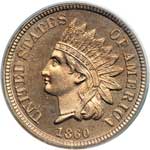 |
1860. PCGS graded Proof 65. CAC Approved. In early 1860 the portrait was redesigned significantly for some unknown reason. The main difference in the two designs is the shape of the bust truncation. The type of 1859 has a short pointed bust truncation. The type adopted in 1860 has a more rounded bust point. All Proofs are struck from the rounded bust design.
Prooflike fields and outstanding surfaces. The coin has all the appearences of the Proof issue and may be a proof striking. Accoring to Rick Snow's it shares the same die diagnostics as the Snow-PR1 proof issue. Eagle Eye Photo Seal. Only 1,000 struck. Housed in an Old Green Holder. Pop 41; 11 finer in 66. (PCGS # 2253)
The shield adopted for 1860 and used on Indian Cents until 1909 is simple in design � 13 vertical stripes, or the paleways, surmounted by a set of horizontal lines, or chief. Estimated Value $1,500 - 1,700
View details and enlarged photos
Check results on similar lots
Realized
$4,485 |
|
Lot 1079 |
 |
1861. NGC graded Proof 65. CAC Approved. Good mirrors. This is a very difficult date to find. Most come with strike-throughs and imperfections due to minting problems. This coin is lacking these problems. There are a few light fly specks on the reverse. A bold Gem Proof. Housed in an Old Style Holder. Pop 21; 8 finer in 66. Estimated Value $3,250 - 3,750
View details and enlarged photos
| Realized
$5,290 |
Lot 1080 |
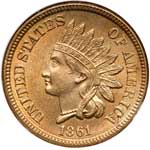 |
1861. NGC graded MS-65. CAC Approved. Straightforward mint luster with flawless surfaces on both sides. Housed in an Old Style Holder. Pop 145; 48 finer, 40 in 66, 4 in 66 Star, 1 in 66+, 3 in 67.
Historic note on the year 1861. In the 1860s, several Southern states lawfully seceded from the United States after an impasse regarding unfair taxation. It seems that most of the taxes were collected in the South while most of the tax money was spent on public works programs in the North. The Southern States seceded and reasserted themselves as individual sovereign nations. In 1861 they adopted the Confederate States of America constitution. The basis of their government was much like the original US constitution that only allowed for a weak central government with little or no taxing authority. Since their original dispute was over excess taxation in the form of tariffs the new CSA government certainly could not pass an excessive tariff to collect revenues in good conscience. While the South only wanted to go their separate way and be left alone it seems that President Lincoln had other ideas. Lincoln stated that he would never let the South go because they were needed to pay the taxes to support his internal improvements in the North (public works spending on canals, railroads, etc). Estimated Value $900 - 950
View details and enlarged photos
| Realized
$1,035 |
Lot 1081 |
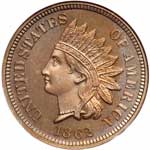 |
1862. NGC graded Proof 65. CAC Approved. Housed in an Old Style Holder. Sparkling surfaces with lovely almost lilac tan patina giving way to a more crimson gold on the obverse at right and central reverse. The 1862 is one of the important and underrated early copper-nickel Proof pieces struck, of which far fewer are known today than the mintage would suggest. Pop 78; 34 finer, 30 in 66, 4 in 67. Estimated Value $1,500 - 1,600
View details and enlarged photos
| Realized
$2,128 |
Lot 1082 |
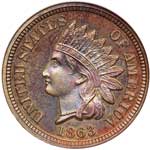 |
1863. NGC graded Proof 65. Medium mirrors. Light golden tone. Housed in an Old Style Holder. The 1863, while it is one of the more frequently encountered business strike copper-nickel Cents, in Proof the opposite is the case as only 460 Proofs were struck in this copper-nickel format. The original white-gray surfaces are now toned over with an even dusky rose and lilac patina. The fields are original, and this reflectivity adds a smooth sheen to each side that contributes considerably to the coin's overall eye appeal. A small mark at Liberty�s neck is noted. Scarce, with relatively low population: Pop 32; 6 finer in 66.
Mint Director Pollock left no stone unturned in his efforts to obtain more nickel for coinage during the crisis years of the civil war, according to researches by Robert W. Julian. "Mint capacity was about 75 million copper-nickel cents per year, but the best effort, in 1863, produced only about 50 million. There simply was not enough nickel available from European refineries."There was an American supplier, Joseph Wharton, who had a nickel mine at Lancaster Gap, Pennsylvania, but his deliveries were erratic and unpredictable. His works were sometimes shut down for weeks at a time for repairs. As early as the summer of 1863, Pollock knew that something had to be done; he recommended to the Treasury that bronze be substituted for copper- nickel."Toward the end of 1863, Pollock was determined to introduce bronze coins. A draft bill was prepared for submission to Congress, but Treasury Secretary Chase did nothing for some months. The secretary was under strong pressure from Wharton's supporters in Congress.". Estimated Value $1,400 - 1,500
View details and enlarged photos
| Realized
$1,553 |
Lot 1083 |
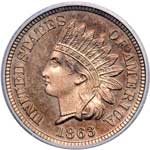 |
1863. ICG graded PR-65. Nice golden toning. This sparkling Gem boasts swirling reflective effects in the field and uncommonly sharp striking detail for the issue. Even this condition of the surface integrity isn't enough. The supporting strike, as mentioned, is just as strong, and desirable with clear definition to the key design points. Estimated Value $750 - 800
View details and enlarged photos
| Unsold |
Lot 1084 |
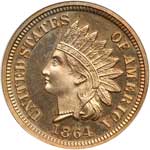 |
1864. Copper-nickel. NGC graded Proof 65. Good mirrors with great eye appeal and very few marks. Housed in an Old Style Holder. Only 370 struck. We are fortunate to be offering several high grade copper-nickel representatives of this Proof release from 1859 to 1864. The present example noticeable cameo accents which produces a beautiful coin, the light coppery tan tinged surfaces shimmer with glassy, distraction-free fields. A few wispy hairlines is all one finds with a magnifying glass. The devices are equally well preserved, satin rather than reflective, of course. And powerfully impressed. Worthy of inclusion in a high-grade Indian Cent collection. Pop 27; 9 finer in 66. Estimated Value $1,500 - 1,800
View details and enlarged photos
| Realized
$1,955 |
Lot 1085 |
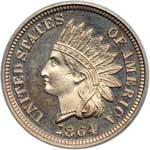 |
1864. Copper-nickel. PCGS graded Proof 64. CAC Approved. Deep mirrored fields and highly frosted devices. This is an outstanding example of the issue with very few of the flaws one would associate with the grade. There is a slight haze on the reverse which is indicative of it's originality. The coin looks like it was just taken out of an original Proof set. Housed in an Old Green Holder. Only 370 struck. Pop 80; 54 finer, 2 in 64+, 43 in 65, 7 in 66, 2 in 67. (PCGS # 2265)
According to Neil Carothers in his book Fractional Money (1930), the number of copper-nickel Cents in the country at the outbreak of the civil war in 1861 was not far from 100,000,000. These coins had been forced into circulation by exchange for Spanish silver coins as well as by sales for gold and silver coins of the United States, until they flooded the channels of retail trade, became a public nuisance, and sold at a discount -- an actual discount to face value! -- in the cities.
These copper-nickel coins, worth as bullion about half as much as their money value, did not disappear when the silver coins vanished in July 1862. They continued to circulate and for a short while, before the vast outpouring of shinplasters (unbacked paper money), they constituted the only small change in the Northern states. The coins were tied up into bundles of 25, 50, or 100 pieces and used widely in retail trade. Bus companies, theaters, and restaurants accepted these rolls everywhere. It is reported a retail store in New York received so many that the floor of the room in which they were stored collapsed! Estimated Value $800 - 1,000
View details and enlarged photos
Check results on similar lots
| Realized
$1,725 |
Lot 1086 |
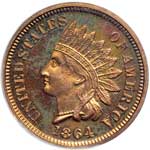 |
1864. Bronze. PCGS graded Proof 65 Red. Deep mirrors with frosted devices. Graded over 15 years ago, prior to the "Cameo" designation being given by PCGS. It looks like it could possibly gain that designation were it submitted today. This is an outstanding example with wonderful eye appeal. This issue is highly desired as a one-year type coin. Very few examples exist that could be called its equal or better. The minatge estimate of 150 should be revised to 300 accoring to researcher Rick Snow. Housed in an Old Green Holder. Only an estimated 300 struck. Pop 7; 2 finer, 1 in 66, 1 in 67. (PCGS # 2278) Estimated Value $7,000 - 8,000
View details and enlarged photos
Check results on similar lots
| Realized
$5,290 |
Lot 1087 |
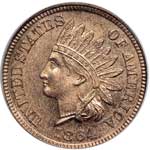 |
1864. Bronze. PCGS graded Proof 65 Red & Brown. Nearly full red. Decent mirrors with very few flaws. This issue is usually found close to brown and example with this much red are in very high demand. This is a popular one-year type coin with the design of the 1860-1864 copper-nickel issues and the bronze planchets begun this year. The necessity in changing the metal of the cent was brought on by the rapid inflation of the currency during the Civil War. Copper-nickel cents dissapeared from circulation or were offered at a 20% premium. Cheap private copper tokens successfully circulated in the Northern cities in their place. Faced with the choice of minting coins that were not being used or offering a Federal substitute for the tokens, Treasury Secretary Salmon P. Chase choose to substitute the metal in the cent with bronze.
Very few 1864 Bronze Indian Cents were struck. The classic mintage figure usually quoted is 150, but this estimate is not accurate in light of the numbers sent for certification. A revised mintage estimate of 300 is given by Rick Snow in his Flying Eagle and Indian Cent Attribution Guide. Housed in an Old Green Holder. Only 300 estimated struck. Pop 32; 14 finer, 13 in 66, 1 in 67. (PCGS # 2277) Estimated Value $2,500 - 3,000
View details and enlarged photos
Check results on similar lots
| Realized
$2,300 |
Lot 1088 |
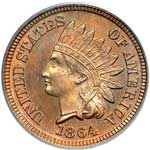 |
1864. Bronze. PCGS graded Proof 64 Red. Medium mirrors. Even color, although slightly muted. Small spot on the reverse rim at 6:00. A scarce one-year type. Estimated 300 struck. To aid the Mint in coining large numbers of the new bronze coins beginning in 1864, a private company received a contract to prepare blanks for the new bronze coinage. With this help, the Mint was able to strike nearly 60 million coins in the last seven months of 1864. The small coin shortage was over. Proof issuance, however, continued, but in very small numbers until 1878. Pop 13; 9 finer, 7 in 65, 1 in 66, 1 in 67. (PCGS # 2278) Estimated Value $1,800 - 2,000
View details and enlarged photos
Check results on similar lots
| Realized
$2,358 |
Lot 1089 |
 |
1864. Bronze, with "L". PCGS graded MS-65 Red. Full strike with outstanding luster. Very fewm marks or imperfections. This is a very popular type with the initial "L" for Longacre added to the ribbon below the last feather. The entire design was sharpened by Longacre when the change was made from copper-nickel to bronze planchets. This design change was not officially mandated and was not noticed by numismatists for many years after its mintage. As a result, it was not saved as a scarce type and today is very scarce in high grades. Housed in an Old Green Holder. Pop 33; 4 finer, 1 in 65+, 3 in 66. (PCGS # 2081) Estimated Value $4,000 - 4,500
View details and enlarged photos
Check results on similar lots
| Realized
$3,795 |
Lot 1090 |
 |
1865. PCGS graded Proof 65 Red. A very scarce date and very tough in this grade. The mirrors are good with frosted devices. Graded prior to PCGS giving the "Cameo" designation. Only 500 struck. This is a very difficult date to find in gem full red. Like many other dates in this series, the rarity of the coins struck in Proof format have no relation to the rarity of the regular issues. Non-Proofs are fairly common for this date. Not so for the Proofs. The mintage currently given in references is 500, which may be generous.
This issue is notorious for having low percentage of red. Many of the planchets used for the Proofs were on streaky planchets. When the alloys of Tin and Zinc are not mixed well into the copper, pockets of alloy remain in the bronze ingot. As the ingot is rolled out, these pockets get elongated and eventually turn into streaks on the finished planchets. Tin and Zinc are very volatile and will not hold the original color of the coin. The few 1865's that remain in full red are presumably from a higher quality melt, and are very rare and desirable because of this. Notice the very low census: Pop 8; 1 finer in 66. (PCGS # 2284) Estimated Value $3,000 - 3,500
View details and enlarged photos
Check results on similar lots
| Realized
$5,290 |
Lot 1091 |
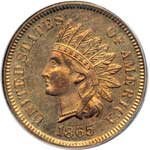 |
1865. PCGS graded Proof 65 Red. Good mirrors. Original surfaces. It looks like it just came out of its original envelope. Slight muting on the high points as a result. This is a very scarce date. Only 500 struck. Pop 8; 1 finer in 66. (PCGS # 2284) Estimated Value $1,800 - 2,200
View details and enlarged photos
Check results on similar lots
| Realized
$2,415 |
Lot 1092 |
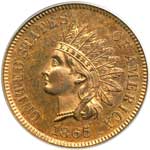 |
1865. PCGS graded Proof 64 Red & Brown. CAC Approved. Mostly full red obverse and toned reverse. A small contact mark on the cheek limits the grade. Very scarce date in Proof. Housed in an Old Green Holder. Only 500 struck. Pop 68; 27 finer, 22 in 65, 5 in 66. (PCGS # 2283) Estimated Value $500 - 600
View details and enlarged photos
Check results on similar lots
| Realized
$633 |
Lot 1093 |
 |
1866. PCGS graded Proof 65 Red. CAC Approved. Good mirrors and wonderful eye appeal. This is a scarce early date, as one might expect from such an early issue, the 1866 is a very elusive in high grades and with full red color. Eagle Eye Photo Seal. Only 725 struck. Pop 14; 3 finer in 66. (PCGS # 2287) Estimated Value $1,800 - 2,000
View details and enlarged photos
Check results on similar lots
| Realized
$5,290 |
Lot 1094 |
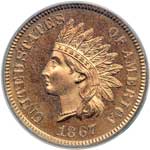 |
1867. PCGS graded Proof 65 Red. CAC Approved. Good mirrors and frosted devices. Graded prior to PCGS giving the "Cameo" designation. There are numerous die polish lines normally found on this issue which are, of course, not grade limiting. This coin has virtually no external marks at all and one of the finest graded examples by PCGS. Housed in an Old Green Holder. Only 625 struck. Pop 11; none finer at PCGS. (PCGS # 2290)
If President Millard Fillmore (1850-53) couldn't read Latin, Andrew Johnson (President, 1865-69) was lucky to be able to read at all. He never went to any kind of school; his wife taught him to read. He is often held up as an example of a failed presidency. Instead, he seems to have made one of the best deals for the American people ever -- buying Alaska from Russia in 1867 for $7.2 million, the year of this lovely Indian Cent Proof. Who has added so much since? What other President has actually made the nation richer, rather than poorer? Johnson did the nation a great service. Still, he gets little respect and practically no thanks. They ought to honor him on a coin made from melted down Alaskan gold nuggets. Estimated Value $4,000 - 4,500
View details and enlarged photos
Check results on similar lots
| Realized
$8,050 |
Lot 1095 |
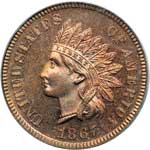 |
1867. PCGS graded Proof 65 Red. Good mirrors and frosted devices. This is a very attractive example with outstanding eye appeal. It stands as one of the finest graded by PCGS and has a chance at a cameo designation were it resubmitted. The holder is the "Series" style which was used prior to the Cameo designation being included on the holder.Eagle Eye Photo Seal. Only 625 struck. Pop 11; none finer at PCGS. (PCGS # 2290) Estimated Value $4,000 - 4,500
View details and enlarged photos
Check results on similar lots
| Realized
$3,795 |
Lot 1096 |
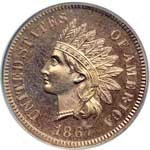 |
1867. PCGS graded Proof 65 Red. Deep mirrors and frosted devices. It is in a "Series" holder, graded prior to the "Cameo" designation being given by PCGS. There are a scattering of minute flyspecks on the obverse, but it has wonderful eye appeal. One of the finest graded by PCGS. Only 625 struck. Pop 11; none finer at PCGS. (PCGS # 2290) Estimated Value $4,000 - 4,500
View details and enlarged photos
Check results on similar lots
| Realized
$5,060 |
Lot 1097 |
 |
1868. PCGS graded Proof 65 Red. CAC Approved. Good mirrors and slightly frosted devices. A very attractive example with outstanding eye appeal. There are a few light flyspecks by the first three feathers. Numerous die polish lines are scattered in the fields, but these are on the die and are not grade-limiting. There are very few actual post-strike marks. The reverse is rotated 160 degrees clock-wise. Housed in an Old Green Holder. Only 600 struck. Pop 9; 2 finer in 66. (PCGS # 2293) Estimated Value $3,750 - 4,250
View details and enlarged photos
Check results on similar lots
| Realized
$8,338 |
Lot 1098 |
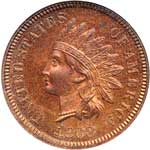 |
1868. NGC graded Proof 65 Red & Brown. About 50% red. Medium mirrors. The reverse is rotated nearly 180 degrees. Housed in an Old Style Holder. Only 600 struck. Pop 24; 12 finer, 11 in 66, 1 in 67. Estimated Value $600 - 700
View details and enlarged photos
| Realized
$834 |
Lot 1099 |
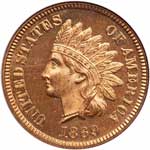 |
1869. NGC graded Proof 65 Red. Good mirrors with blazing gold color. Great eye appeal. Small stain on the F in OF. The reverse is rotated 10 degrees clockwise. Housed in an Old Style Holder. Only 600 struck. Pop 12; 5 finer in 66.
A coin issued during one of the most hectic years on record. First, there was a nearly successful attempt to corner the New York gold market by crafty speculators which confounded money men world-wide; then, too, the first cross-country railroad link was completed with the pounding-in of the golden spike at Promontory, Utah to similar world-wide news coverage. It is interesting to note that the mintage of Proof Indian Cents at the Philadelphia Mint continued fairly normal at between 500 and 1100 pieces compared to that of Philadelphia during the years following 1877 when Proof mintage ratched up noticeably. One reason for this divergence was that the East was recovering from the devastating effects of the 1861-65 War. Estimated Value $2,250 - 2,500
View details and enlarged photos
| Realized
$1,668 |
Lot 1100 |
 |
1870. PCGS graded Proof 65 Red. Medium mirrors as is typical with this issue. Very few marks. Only a small spot by the T in CENT limits the garde. Housed in an Old Green Holder. Only 1,000 struck. Pop 24; 4 finer in 66. (PCGS # 2299) Estimated Value $2,000 - 2,500
View details and enlarged photos
Check results on similar lots
| Realized
$2,990 |
Lot 1101 |
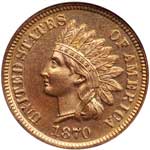 |
1870. NGC graded Proof 65 Red. CAC Approved. Medium mirrors, which is typical for this issue. Many die polish lines, but few, if any post-minting marks. This same reverse die is found on the restrike 1864-L Proof issues, Snow-PR2. Housed in an Old Style Holder. Only 1,000 struck. Pop 8; 6 finer in 66. Estimated Value $1,750 - 1,850
View details and enlarged photos
| Realized
$2,070 |
Lot 1102 |
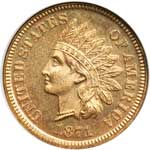 |
1871. NGC graded Proof 65 Red. Shallow N, as are most Proofs of this date. Medium mirrors, as is typical for this date. Very few marks or problems. A very scarce date in Proof. Housed in an Old Style Holder. Only 960 struck. Pop 14; 2 finer in 66. Estimated Value $2,000 - 2,250
View details and enlarged photos
| Realized
$1,840 |
Lot 1103 |
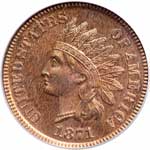 |
1871. PCGS graded Proof 64 Red & Brown. CAC Approved. Medium mirrors. about 50% red with no marks or problems. Housed in an Old Green Holder. Pop 104; 45 finer, 42 in 65, 1 in 65+, 2 in 66. (PCGS # 2301) Estimated Value $500 - 600
View details and enlarged photos
Check results on similar lots
| Realized
$575 |
Lot 1104 |
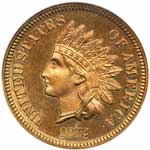 |
1872. NGC graded Proof 66 Red. A blazing gem displaying golden and fiery red russet toning. A beautiful semi-cameo gem example. Resplendent mirrors, as deep as ever seen for this date which provide for a breathtaking appearance. The sparkling fields display subtle ever-changing accents of coppery iridescence. Original production was approximately 950 Proofs, however only a handful of 1872 Cents survive at this outstanding Proof 66 Red grade level. Pop 3; none finer at either NGC or PCGS. This is certainly one of the finest proofs to exist. Estimated Value $5,000 - 5,500
View details and enlarged photos
| Realized
$4,830 |
Lot 1105 |
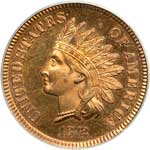 |
1872. PCGS graded Proof 65 Red. Well struck with dappled light to medium-red color on the obverse and reverse, with both sides lightly frosted at devices. Free of few carbon specks, sans marks, and virtually no hairlines or contact marks are seen. A first-rate Gem Proof! Do you imagine that there will be a single Indian Cent collector in this country with the price of the coin in his bank account and a pair of sharp eyes on his face who will not scramble and kick to acquire this highly presentable Proof coin? Pop 10; 6 finer in 66. (PCGS # 2305) Estimated Value $2,500 - 2,700
View details and enlarged photos
Check results on similar lots
| Realized
$2,818 |
Lot 1106 |
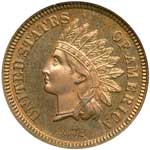 |
1872. NGC graded Proof 65 Red & Brown. About 50% red. Medium mirrors. Housed in an Old Style Holder. Only 950 struck. Pop 44; 9 finer in 66.
The 1872 Proof issue was struck in about the same quantities as the other dates in the early 1870's, but for some reason, are much scarcer than other dates in gem full red grades. Most of the encountered examples are some shade of red brown, as here with about half the origiinal red color present. There is strong additional date demand for this issue due to the rarity of the non-Proof format issues. Estimated Value $800 - 900
View details and enlarged photos
| Realized
$863 |
Lot 1107 |
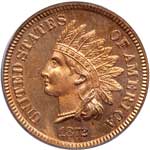 |
1872. PCGS graded Proof 64 Red. Medium mirrors. Bright gold color. Very tough date. Small planchet defect by the lower hair curl. Housed in an Old Green Holder. Pop 38; 16 finer, 10 in 65, 6 in 66. (PCGS # 2305)
The Great Epizootic of 1872. (Sounds like a chapter out of a Frank Baum "Wizard of Oz" novel!). Called the "Great Epizootic", an outbreak of equine influenza in 1872 caused the whole transport system of the Midwest, the South, the East Coast and even as far away as Cuba and Mexico, to grind to a halt for weeks on end. The number of sick horses approached 100% and mortality rates ranged between 1% and 10%. Many horses were unable to stand in their stalls and those who could stand coughed violently and were too weak to pull loads.
Every aspect of American transportation was affected by it. Locomotives came to a halt as coal could not be delivered by horse drawn wagons to power them, while fires in many major cities raged unchecked due to lack of mobility of the horse drawn fire trucks. One fire in Boston destroyed over 700 buildings in 1872. Even the United States Army Cavalry was reduced to fighting the Apaches on foot, who likewise found their mounts too sick to do battle. The outbreak forced men to pull wagons by hand, while trains and ships full of cargo sat unloaded, tram cars stood idle and deliveries of basic community essentials were no longer being made. The affect this disease had on the US economy should not be understated. Estimated Value $800 - 900
View details and enlarged photos
Check results on similar lots
| Realized
$1,495 |
Lot 1108 |
 |
1872. PCGS graded MS-62 Brown. Lustrous brown surface; excellent strike on this scarcer date in the 1870s (PCGS # 2103) Estimated Value $800 - 850
View details and enlarged photos
Check results on similar lots
| Unsold |
Lot 1109 |
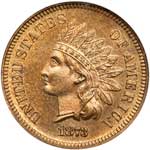 |
1873. NGC graded Proof 66 Red & Brown. CAC Approved. Very close to full red. Even color with hardly any imperfections. Housed in an Old Style Holder. Only 1,100 struck. The Closed 3 date style is used on the early dies of 1873 made prior to Chief Coiner A.L. Snowden's complaint on January 18th regarding the similarities of the look of the date to 1878. All Proofs this year are of the closed 3 style. The reported mintage of 1,100 seems to be in line with the rarity of examples seen in the marketplace. This is an almost impossible coin to locate in gem full red condition. This is due to the sloppy die preparation, which produced coins that do not seem to excite very often. Pop 19; none finer at NGC.
Historic Note: During the 19th century, the federal government in Washington, D.C. was generally happy to do favors for Wall Street financiers. Railroad tycoons, who often used their railroads as vehicles of extravagant speculation, enjoyed subsidies, tax exemptions, loans, and a whole smorgasbord of financial fringe benefits supplied by pliable congressmen and senators (not to mention armadas of state and local officials).
The Crédit Mobilier was a joint-stock company organized in 1863 and reorganized in 1867 to build the Union Pacific Railroad. It was involved in such a scandal in 1872 in which high government officials were accused of accepting bribes. The firm finally blew up in the credit collapse and ensuing Panic of 1873. (The Enron or Bear Stearns of its day.)
Football anecdote 1873: Andrew Dickson White, President of Cornell University, refused to allow his college's football squad to travel to Cleveland in 1873 for a game against Michigan. Said President White: "I will not permit 30 men to travel 400 mi. to agitate a bag of wind." Estimated Value $1,400 - 1,500
View details and enlarged photos
| Realized
$2,070 |
Lot 1110 |
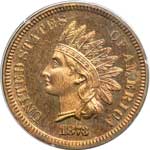 |
1873. Closed 3. PCGS graded Proof 65 Red. Medium mirrors. Very few marks. Small stain by the M in AMERCIA. Housed in a PCGS First Generation Holder. Pop 28; 2 finer in 66. (PCGS # 2308) Estimated Value $1,000 - 1,100
View details and enlarged photos
Check results on similar lots
| Realized
$2,128 |
Lot 1111 |
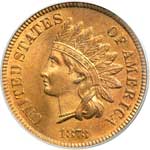 |
1873. Open 3. PCGS graded MS-65 Red. Full strike with very few marks. Slightly muted color on the reverse. A very scarce date in this condition. Housed in an Old Green Holder. Pop 21; 4 finer in 66. (PCGS # 2108) Estimated Value $2,500 - 3,000
View details and enlarged photos
Check results on similar lots
| Realized
$3,631 |
Lot 1112 |
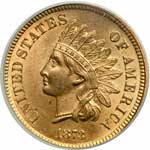 |
1873. Open 3. PCGS graded MS-64 Red. CAC Approved. Brilliant golden-tan color. Housed in an Old Green Holder. Two varieties this year, Close 3 and Open 3. Pop 50; 27 finer, 1 in 64+, 21 in 65, 4 in 66. (PCGS # 2108) Estimated Value $950 - 1,050
View details and enlarged photos
Check results on similar lots
| Realized
$1,121 |
Lot 1113 |
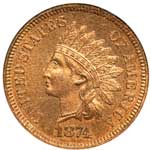 |
1874. NGC graded Proof 65 Red. Medium mirrors. Very few marks or imperfections. Housed in an Old Style Holder. Only 700 struck. Pop 11; 2 finer in 66.
Historic Note: Everyone is familiar with the California Gold Rush that began in 1849; some may have learned about the 1898 Alaskan Gold Rush. In-between was yet another American mad dash for the precious substance. It happened the year this delightful 1874 Proof Indian Cent found its first home in an appreciative collector�s set. The Black Hills Gold Rush took place in Dakota Territory in the United States. It began in 1874 following the Custer Expedition and reached a peak in 1876-77.
Prospectors found gold in 1874 near present-day Custer, South Dakota, but the deposit turned out to be small. The large placer gold deposits of Deadwood Gulch were discovered in November 1875, and in 1876, thousands of gold-seekers flocked to the new town of Deadwood (popularized in movies and television series), although it was still within Indian land. Estimated Value $2,000 - 2,250
View details and enlarged photos
| Realized
$2,070 |
Lot 1114 |
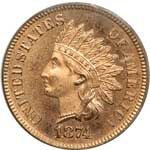 |
1874. PCGS graded Proof 65 Red. Eagle Eye Photo Seal. Housed in an Old Green holder. The lovely bright copper-red surfaces surround devices that are razor-sharp and show; fields show ample reflectivity throughout. A scarcer Proof. Pop 9; 6 finer in 66. (PCGS # 2311) Estimated Value $1,800 - 1,900
View details and enlarged photos
Check results on similar lots
| Realized
$4,255 |
Lot 1115 |
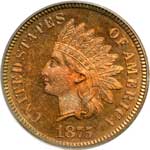 |
1875. PCGS graded Proof 65 Red. Even, deep cherry-red to warm golden patina covers each side of this extraordinary Gem Proof. Deeply mirrored as well with no evidence of contact on either side. Devices lightly frosted. This is a year where the production of Proofs was not given the quality control seen in other years. Every denomination in the Proof set is hard to find in the higher grades due to this lack of quality standards. For years they were unknown in PR65RD. A few are now known, such as this beautiful example, some even postulating it is perhaps because the grading services lowered their expectations due to the quality of extent examples. Very scarce, as are most pre-1880 dates in this grade. Pop 12; 2 finer in 66. (PCGS # 2314)
Forgotten now, the lowly Indian cent increased in purchasing power throughout this decade. In fact, there was a "broad drop in prices" following the end of the American Civil War (1861-65). From 1866-1879, prices (and wages) declined steadily. This can be attributed partly to the withdrawal of a large portion of the paper money (the greenbacks) which had been issued to finance the Civil War (official name, War of the Rebellion). While greenbacks were accepted in most of the country, in California (which had a pro-gold sentiment from the Gold Rush '49ers) there was active civil disobedience. People refused to obey the legal tender law, which the authorities found unenforceable. If you tried to pay in greenbacks, people would boycott you and drive you out of business. So California remained on the gold standard through the war. Prices did not decline there from 1866-1879 but did most everywhere else in the country. Due to increased industrial productivity, even though wages were in a slow decline in this period, the overall wealth of the individual increased steadily as new consumer goods come onto the market at affordable prices. Estimated Value $3,000 - 3,300
View details and enlarged photos
Check results on similar lots
| Realized
$3,680 |
Lot 1116 |
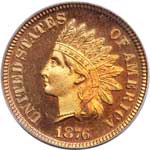 |
1876. PCGS graded Proof 65 Red. Very deep mirrors. Some light fly specks on the reverse. Bright, even orange-red surfaces that show light lovely variation in color including some blast-furnace gold at the center. The fields are well mirrored and a good portion of mint frost is seen over the devices, which provides a luxurious cameo contrast on each side. Pop 20; 8 finer in 66. (PCGS # 2317) Estimated Value $2,000 - 2,500
View details and enlarged photos
Check results on similar lots
| Realized
$5,750 |
Lot 1117 |
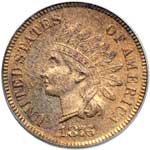 |
1876. PCGS graded Proof 65 Red. Muted mirrors. Some planchet streaks due to uneven alloy in the planchet. Only 1,150 struck. Pop 20; 8 finer in 66. (PCGS # 2317) Estimated Value $1,500 - 1,600
View details and enlarged photos
Check results on similar lots
| Unsold |
Lot 1118 |
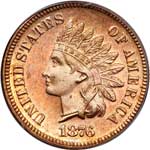 |
1876. PCGS graded Proof 64 Red. Centennial Year. Hence, the somewhat increased mintage which included sales to the general public along with normal numismatic purchases. Good mirrors with very few marks. Some light fly specks are present, Housed in an Old Green Holder. Pop 22; 28 finer, 20 in 65, 8 in 66. (PCGS # 2317) Estimated Value $500 - 600
View details and enlarged photos
Check results on similar lots
| Realized
$891 |
Lot 1119 |
 |
1877. PCGS graded Proof 65 Red. Good mirrors. Beautiful even color. There are hardly any imperfections and it is very high-end for the grade. This is a key date and there should be enormous intrest in this coin. Eagle Eye Photo Seal. Due to the general unavailability and high cost of business strikes in full red condition, Proof 1877 Cents have always been popular collector coins. This is an outstanding Gem Proof 65 that is modestly reflective in the fields, with each side showing rich, even, original mint red color. Struck with mathematical precision by the dies. Pop 19; 13 finer, 11 in 66, 2 in 67. (PCGS # 2320) Estimated Value $8,000 - 9,000
View details and enlarged photos
Check results on similar lots
| Realized
$10,925 |
Lot 1120 |
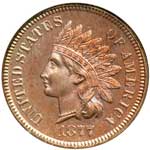 |
1877. NGC graded Proof 65 Red & Brown. Nearly full red. Very few marks or problems. Housed in an Old Style Holder. Only 900 struck. Even though nearly one thousand Proofs were produced in this year, there is never a shortage of buyers because of the tremendous date pressure exerted by the scarcity of high grade business strike 1877 cents. The deep coppery to cherry-red surfaces on this piece show occasional glints of iridescence while the proof fields are nicely reflective. Pop 72; 18 finer, 17 in 66, 1 in 67. Estimated Value $5,000 - 5,500
View details and enlarged photos
| Realized
$4,715 |
Lot 1121 |
 |
1877. NGC graded MS-63 Brown. CAC Approved. Uniform light chocolate color. Popular Key Indian Cent. Housed in an Old Style Holder. A high degree of light brown luster springs to life beneath gentle wood-grain surface highlights. Not exactly razor-sharp but neither are the designs soft at either the obverse or the reverse; we find acceptable detail throughout, more detail than on the typical example of the date. A lively Choice brown example that will please just about any collector of the series, this being the Key Date. Pop 26; 37 finer, 27 in 64, 9 in 65, 1 in 66.
Historic note: "There are no good Indians but dead Indians," exclaimed General Philip Sheridan, who, after Appomattox, was commissioned to "pacify" a wide section of the frontier. In that spirit no small part of the undertaking was realized. "Many, if not most, of our Indian wars have had their origin in broken promises and acts of injustice on our part," laconically remarked President Rutherford B. Hayes in a message to Congress in 1877. Estimated Value $3,000 - 3,500
View details and enlarged photos
| Realized
$3,853 |
|
|